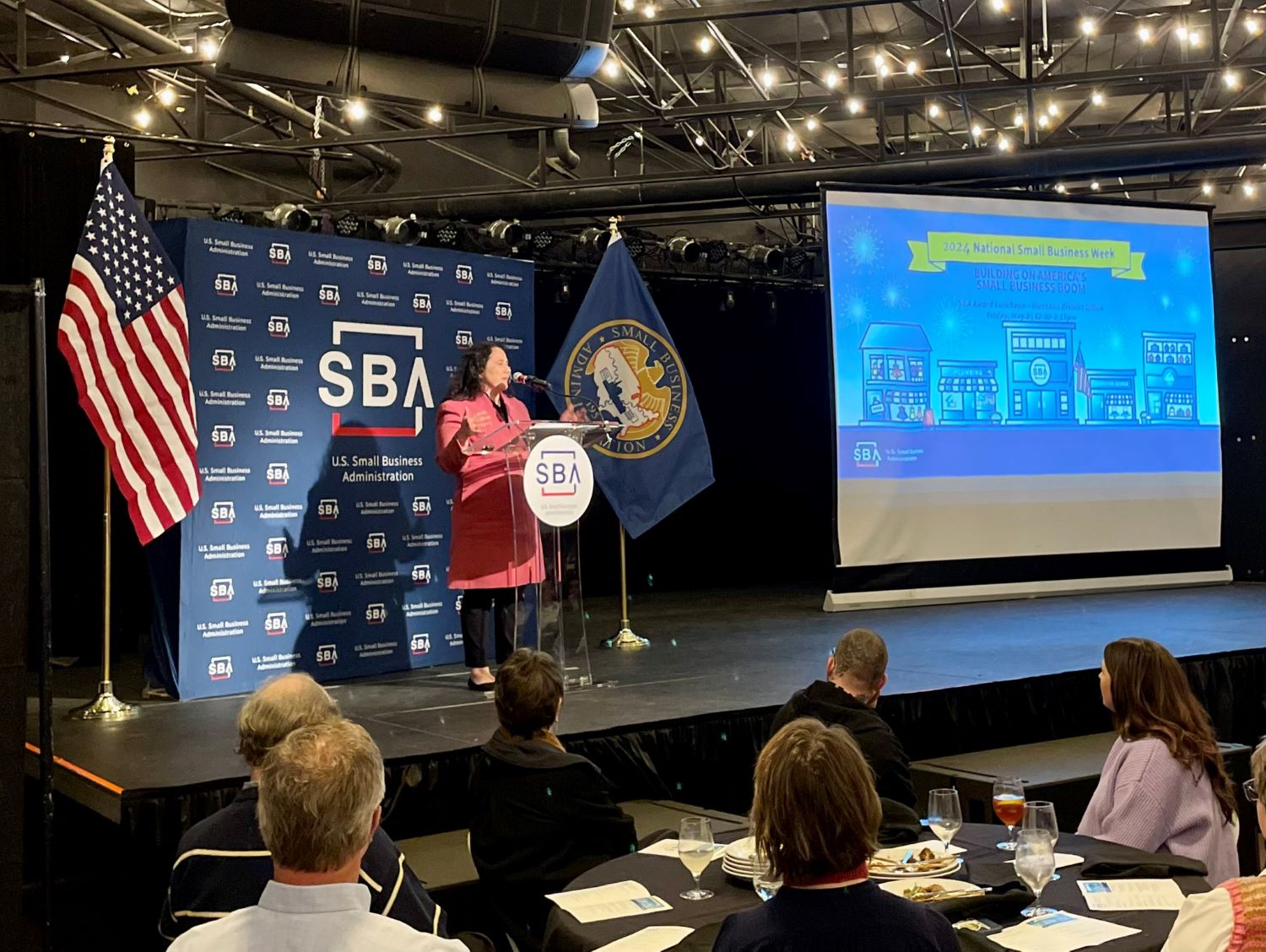Ayanna’s Story: Overcoming Obstacles and Lessons Learned in Subcontractor Sourcing
In the dynamic landscape of Government Contracting, success isn’t solely dictated by expertise; it requires a strategic blend of determination, flexibility, and forward-thinking.
Ayanna McClintic’s journey embodies the complexities and victories of this field. Her astute decision to begin with state and local contracts was a testament to her strategic thinking.
Yet, even amidst this calculated approach, Ayanna encountered valuable lessons as a newcomer, emphasizing the significance of ongoing learning and adaptability in navigating the competitive terrain of Government Contracting.
From Bootcamp to Business: Ayanna’s First Contract Win
Ayanna McClintic started her journey into Government Contracting by attending the Entrepreneurship Bootcamp for Veterans at Texas A&M University. This program aims to provide veterans with comprehensive training in entrepreneurship, covering many aspects of business ownership and management.
“There was an individual there who was talking to us, it was a speaker, and she was talking to us about how she got into Government Contracting,” said Ayanna.
“The boot camp doesn’t not only talk about Government Contracting but also talks about how to own a business, run a business, pretty much everything from A to Z,” she added.
Fascinated by the promising prospects, she decided to pivot from her original business idea of co-hosting for midterm rentals and instead focus on Government Contracting.
After returning from the boot camp, she dove headfirst into understanding the ins and outs of this field without delay.
“After I came back from the boot camp, I opened my new LLC for the Government Contracting,” she shared.
To educate herself, McClintic turned to various resources, including YouTube videos, books, and courses, she even participated in a 5-day Challenge led by Wes Fisher.
Despite facing some initial hurdles, such as being blocked from federal contracts and experiencing delays in obtaining a cage code, McClintic remained determined.
“It delayed me and I’m like, well I still don’t want to just sit here and not do anything, so I’m still going to apply for state and local because I know don’t need a cage code for that, so I started looking for pretty much anything, I threw the blanket wide across the US,” said Ayanna.
Her proactive attitude paid off when she stumbled upon a grass cutting contract in Iowa. Notably, she secured the contract on her first attempt, marking it as her inaugural triumph in the field of Government Contracting.
Preference for State and Local Contracts: A More Flexible Approach
Ayanna’s preference for state and local contracts over federal ones was evident in her approach to structuring her proposal.
She highlighted the flexibility and less prescriptive nature of state and local contracts. She appreciated the simplicity of the requirements outlined by the contracting agency for her particular opportunity.
“Federal does usually tend to spell it out for you and they tell you exactly how they want you to write it and include this, and state and local kind of don’t really have that. This contract did kind of have it in there where they said, ‘we just want you to include your pricing, past performance, like a biography about your business,’ and so it was only like maybe five things and so there was some documents that they wanted included in the proposal,” she said.

When it came to incorporating required documents, such as reference forms provided by the contracting agency, she printed them out and filled them in manually.
“They had their own reference form that they wanted me to fill out, so when I went to UPS, I printed out the forms that they wanted included in my little documents, and I just spilled it out by hand, and I had it already, like set up specifically on what page number that was supposed to fall on, and that’s all I did,” Ayanna shared.
Branching out to state and local contracts offers distinct advantages for businesses in government contracting. Working with local entities fosters more intimate and direct relationships compared to larger federal contracts. These personal connections built up from Ayanna have paved the way for deeper understanding and collaboration, often resulting in repeat business and referrals.
Besides, state and local contracts typically attract fewer bidders than federal ones, providing contractors with a higher chance of securing projects. This reduced competition grants greater negotiating power, enabling firms to secure favorable terms.
Kizzy Parks, the founder of K. Parks Consulting (KPC) and the newly launched GovConWinners, sees the opportunity to register as a vendor while submitting proposals for state and local contracts as a blessing.
“A state and local sometimes you can register to be a vendor as you’re submitting the proposal it’s very easy so I look at it like these are blessings that you have given to people and you will receive the blessings back,” she said.
Efficient Subcontractor Sourcing: Approach to Project Collaboration

Having a subcontractor means you don’t need to be on-site, freeing you to focus on other aspects of the project. And finding subcontractors for project was a straightforward process for Ayanna. She relied on online platforms like Google and Facebook Marketplace to identify potential subcontractors.
“I feel like the fastest and easiest way to find a subcontractor is just go to Google and I look at the top people who have the most reviews, and I read through the reviews to make sure that they’re good, and then I kind of just read to make sure that they can actually do what I am looking for because I have had a few times,” Ayanna shared.
Ayanna also took the time to verify that each subcontractor had the necessary expertise in grass cutting, avoiding any mismatches in services offered.
She recognized the subcontractor’s eagerness for consistent work.
“When he was telling me he was actually really great at staying in touch with me while I was waiting to get this insurance situation sorted out which I’m sure we’ll talk about, but he kept actually following up with me, he’s like honestly the best first subcontractor I could have ever talked to because he’s very understanding of this whole situation of me,” she said.
Ayanna found their mutual understanding and collaboration beneficial, as it allowed her to handle the administrative aspects of bidding on contracts while the subcontractor focused on execution.
“The subcontractor likes the idea of me being that person because he’s so busy running his own business, he doesn’t really have time to bid on contracts, so I even told him on the phone before, I’m like this is like the perfect relationship here because I can find them, bid on them for you, and put together the paperwork, and then you just execute with your team, and he really liked that, so he’s definitely been communicative with me,” she shared.
Comprehensive Proposals: A Process of Clarity
With only a week to compile the proposal, Ayanna swiftly reached out to subcontractors, leveraging their quotes and online reviews to bolster her submission.
Utilizing Canva as her primary tool, she pieced together a visually appealing document reminiscent of a school project, yet effective in its delivery.
“I literally went into Canva and I did have like a form or like a piece of paper where they could write their references, but I also went to the landscaper website, and I screenshot their reviews and I also put that in my proposal and honestly kind of looked like a school project The Proposal in Canva,” she stated.
Besides, clarity is paramount when submitting information to the contracting officer.
When another grass cutting contract emerged in the same city, Ayanna saw an opportunity to streamline the process by resubmitting her previous proposal. However, despite the similarities, she encountered unexpected challenges. The contracting officer for the new opportunity had different requirements, focusing solely on hourly rates.
This discrepancy led to confusion, as Ayanna’s subcontractor received a call indicating they had lost the contract to a competitor offering a lower rate.
“I guess just be really clear when you are submitting information to the contracting officer for them to call you because my subcontractor called me and he’s like ‘I got a call from that other contracting officer, and they said that we lost the contract and somebody else won it for $70 hourly,’ Ayanna noted.
In addition, Ayanna calculated the pricing for her grass cutting contract with careful consideration to ensure competitiveness while covering her costs.
“I didn’t want to price super high out of the gate since this was my first contract, and so I wanted to stay competitive but also still make sure like my costs would be covered,” she said.
Ayanna settled on $60 per grass mowing, a modest increase from the subcontractor’s $50 rate to account for her services and ensure profitability.
For hourly rates, Ayanna similarly adjusted the subcontractor’s rate of $65 to $75 to reflect her added value and cover her expenses.
To determine these rates, she applied a straightforward approach, adding a 15% markup to the subcontractor’s pricing.
“I just added 15% maybe like a little bit more on top so I just said like 15% of $50 and I just rounded up to 60 and call it a day,” she shared.
Insurance Procurement in Contracting Ventures
Ayanna initially planned to wait until winning a contract before obtaining insurance, aiming to avoid unnecessary expenses. However, she discovered that delaying insurance procurement caused undue stress and hindered progress.
“Honestly if I had to do this again, I would not wait because it’s been very stressful trying to get everything together,” she said.

Ayanna grasped how tricky insurance requirements could be, especially when it came to the specific endorsements needed for contracts in that city. Despite encountering difficulties finding suitable insurance providers, she persisted in seeking assistance from friends within the industry, ultimately securing insurance coverage within a short timeframe.
“I kind of collaborated with a friend of mine and she recommended another insurance person for me, she actually ended up finding them for me because it’s easier in this industry to find somebody who has a same bold as you, like my friend we’re both trying because she was also in that boot camp with me,” Ayanna shared.
“And so like I still work a full-time job I work in the operating room and it’s hard for me to make these calls, and she’s like ‘I’ll try to make these calls for you for insurance’, so by the end of the day she was able to find insurance,” she added.
Furthermore, Ayanna realized the significance of clarifying insurance requirements early in the contracting process to prevent delays and misunderstandings.
“Now my next learning curve here was I should have given the information about the insurance to my sub when we first got awarded,” she stated.
She also highlights the challenges of managing insurance coverage for subcontractors, noting that it was not as simple as adding or removing individuals from policies.
Ayanna expressed the need for more guidance from contracting officers, suggesting the provision of contacts from other companies who have navigated similar insurance requirements.
Contracting Opportunities: Venture into the Global Market
Ayanna found great utility in using RFP (Request for Proposal) delivery software, particularly appreciating its ability to compile state, local, and federal contracts in one convenient platform. With a background in web design, she was drawn to opportunities in that field, considering it a niche.
“I typed into RFP delivery which they can send you emails based on saved preferences, but on days when I just want to go in there and search myself, I just typed in web design and the one for Nova Scotia came up and then I was reading through, and it’s for like a tour, it’s like they have a certain tour sites in Nova Scotia, and they wanted to completely redesign the whole website and so I did call two people for quotes,” she shared.
However, she faced some challenges in the competitive landscape of contracting.
In one instance, despite facilitating a site visit for a tree cutting contract, Ayanna found herself sidelined when the subcontractor directly engaged with the client.
Despite this setback, Ayanna chose to take the higher road, recognizing that there’s ample business for everyone.
She has discovered that geographical limitations need not restrict one’s opportunities in bidding for contracts.
Besides, when Kizzy spoke with Ayanna, she underscored the importance of broadening horizons beyond familiar territories in pursuit of contracting opportunities. She shared a personal anecdote about a woman who contacted her regarding work in Jamaica, illustrating the global reach of contracting endeavors.
“Sometimes we’re just focused on what we know, maybe our state or the United States or a certain region, I had a woman reach out to me about work in Jamaica, I mean so you don’t have to limit this to the United States, you can bid all over the world,” Kizzy said.
Mastering Contracting: Ayanna’s Advice
More remarkably, from unexpected twists in contract terms to lessons learned about subcontractor management, Ayanna’s experiences offer valuable insights for anyone venturing into contracting.
The Importance of Reading Contract Papers
Ayanna faced a surprising twist in her contracting journey when she realized that the dates specified in the contract, she received didn’t match what was agreed upon initially.
Initially set from May 1st until November of the current year with the option to extend for two years, the contract’s duration had been modified to span from today until next year, with the extension option remaining intact.
Fortunately, Ayana caught this discrepancy early on and immediately recognized the need to update her subcontractor agreement to align with the new contract dates.
So, it is important to carefully review all contract documents provided by the contracting officer.
“Make sure that you read through the contract that their officer sends you, because it’s changed, so now I have to change my paperwork with my sub,” Ayanna said.
Why Avoiding Subcontractor Information in Proposals Matters

Besides, Ayanna learned a crucial lesson about the importance of not including subcontractor contact information in proposals.
It was an interesting experience when another grass cutting contract emerged in the same city with a different contracting officer. Ayanna decided to use the same paperwork she had just submitted for the previous contract.
However, they ended up losing this one because the contracting officer only wanted hourly rates, not the additional details Ayanna had included.
Next time, Ayanna plans to ensure that the contracting officer contacts her directly regarding contract awards. This experience highlighted the significance of maintaining control over communication channels and avoiding disclosing subcontractor contact information in proposals.
“It’s part of the learning tag,” Ayanna noted. Keeping subcontractor contact information private ensures that all communication flows through her, similar to the way Amazon manages customer issues directly instead of involving third-party sellers.
“Because you never want their contact information anywhere there ever, never put the subcontractor’s contact information into your proposal because you always want them to come to you,” she added.
Handling Subcontractor Challenges with Grace
Despite encountering instances where subcontractors have bypassed her or pursued opportunities independently, Ayana maintains a pragmatic and constructive approach to these challenges.
Ayanna’s experience highlights this, as she reflects on instances where subcontractors circumvented her involvement to secure contracts directly.

When she learns that a subcontractor she contacted directly has been approached by the client separately, she accepts the outcome gracefully. Similarly, when a subcontractor she engaged to provide a quote independently pursues the opportunity without her involvement, she maintains a positive attitude and simply moves on to the next opportunity.
“I feel like maybe after we did our interview they probably went and search it out themselves so I lost on that sub which is fine, so honestly I probably submitted in competition with them which is fun because this will happen in state and local because there’s no barrier to entry… that will happen where sometimes you’ll just get subs that undermine you,” she said.
“I called back the sub that I contacted and I’m like ‘hey if you want to go over there right now, you can check out the area now… so he went out there and I didn’t hear back from the contractor, so then the next day I called and I was like, ’hey, were you able to get a quote’, he’s like, ‘I ended up passing it off to my father’, she stated.
Launching into Contracts: Begin with Simplicity
In selecting contracts, she opts for simpler ones with fewer requirements. This deliberate choice stems from insights gleaned from various sources, including YouTube channels.
“I’ll pick the ones that have maybe one to two to three attachments, and it doesn’t require a lot of things, and I think those are good for maybe your first one or two that you submit on that way also like you’re not wasting a bunch of time,” said Ayanna.
By targeting simpler contracts, she minimizes the time and effort invested in proposal writing, avoiding the potential discouragement of investing heavily in a complex proposal only to lose the bid.
“It’s better to go after smaller ones first, get one or two wins under your belt, and then be like, ‘Okay, I have some skin in the game now. I want to try and go after some of these bigger ones,'” she added.
Harness Tools for Streamlined Workflows
Ayanna believes in the power of technology to streamline processes and enhance efficiency. Utilizing tools like Max Ai, an AI-powered add-on for PDF documents, she significantly expedites her contract review process.
“With Max Ai, I can get through proposals much faster,” Ayanna explains. “I’ve set up a template to feed to the AI, specifying the details I need, like the Contracting officer’s name, scope of work, and proposal requirements. In less than a minute, Max Ai extracts all the necessary information, giving me a quick overview of whether the contract is worth pursuing.”
This approach saves Ayanna valuable time, allowing her to make informed decisions about which contracts to prioritize.
Furthermore, she emphasizes the importance of verifying the AI-generated information to ensure accuracy.
In addition to Max Ai, Ayanna also leverages ChatGPT to assist in formulating detailed responses or paragraphs, particularly when articulating her approach to project execution.
Besides, Ayanna relies on Monday as her CRM (Customer Relationship Management) tool, citing its organizational capabilities as essential to her contracting workflow.
“You can use Excel Sheets if you can’t afford to pay for anything right now, but I like Monday because I am able to keep track of emails to everybody inside the CRM and it lets me know when they’ve opened them or not as well,” she stated.
Ayana’s also streamlining her contracting processes with email templates.
“But I also have email templates just to create less of like a mental exhaustion process because you always having to think of all these little things, I just want to make the process as fast as possible…I’m just going to select this template and change little details here, so I have a template in there about letting the sub know that I’m the one who’s like going to be managing the contract,” she added.









